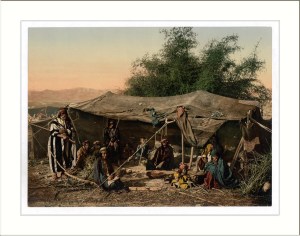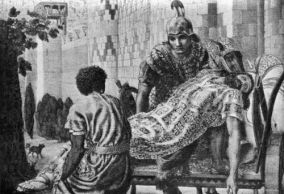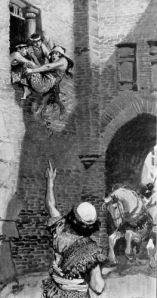And on the Sabbath day we went out of the city to the riverside, where prayer was customarily made; and we sat down and spoke to the women who met there.
Now a certain woman named Lydia heard us. She was a seller of purple from the city of Thyatira, who worshiped God. The Lord opened her heart to heed the things spoken by Paul. And when she and her household were baptized, she begged us, saying, “If you have judged me to be faithful to the Lord, come to my house and stay.” So she persuaded us. (Acts 16:13-15)
In one paragraph, Luke introduces Lydia, the first lady converted through Paul’s preaching in Philippi. Lydia owned a business and a home. She hosted Paul and his companions while they were in Philippi. Scholars have studied her name, her business, and her role in the church at Philippi to enhance Luke’s description.
Person or place?
Commentators say the lady’s proper name may not have been Lydia. She may have been known as the Lydian woman because she came from the region of Lydia in Asia Minor. Although Lydia might have been her proper name, “it seems more likely that it merely means ‘the Lydian,’ and that it was the designation by which she was originally known in Philippi.” [1] Some commentators propose that the lady was actually either Euodia or Syntyche referred to in Phil.4:2.[2] Luke identified her as Lydia, a common name for women in Phoenicia at one time, and mentioned no other name for her.
Her heritage
Was she a Jew? Based on the words that she was “a worshiper of God,” scholars believe Lydia was not a Jew by birth but was a Jewish proselyte.[3] Lydia kept the Sabbath. She was among the women who assembled by the riverside and heard Paul preach about Jesus Christ.
Her trade
What did it mean to be a “seller of purple”? Did she sell dye? Purple cloth? Purple garments? Scholars say she could have sold any of these items or a combination of them all and be considered a “seller of purple.” One source suggests she sold cloth and garments of deep turkey red, commonly made in her hometown of Thyatira.
From snails to dye
The remarkable Tyrian purple was made from a secretion of the predatory sea snail, Murex brandaris. Murex snails flourished in the eastern Mediterranean along the coast of Phoenicia. The Tyrians learned a “secret method of extracting the glandular substance from which dye was produced.” The Roman writer Vitruvius stated that Tyrian “purple exceeds all colors in costliness and superiority of its delightful effect.”[4] Because thousands of snails were crushed to produce a small amount of dye, it was expensive. Until the Murex snails were over-harvested, the wealth of Tyre was based primarily on the manufacture of dye and trade in purple cloth.
Commercial centers
Tyre operated a famous dye-works. Purple silk from Tyre was the finest fabric available. Wearing Tyrian purple garments—silk, cotton, or wool—symbolized power. “There was great demand for this fabric as it was used on the official toga at Rome and in Roman colonies.”[5]
Thyatira, a city in the region of Lydia, also operated a dye-works, and it was famous for the color red. Dyers in Thyatira used a red vegetable dye made from madder root. “The waters of Thyatira are said to be so well adapted to dyeing that in no place can the scarlet cloth of which fezes are made be so brilliantly or so permanently dyed as here.”[6] The dyers developed a process involving “sumac and oak galls, calf’s blood, sheep’s dung, oil, soda, alum and a solution of tin” (“Rubia,” Wikipedia). In time the Lydian guilds produced purple cloth that competed with the fabric of Tyre. It was said that the Lydians were “celebrated for their dyeing, in which they inherited the reputation of the Tyrians.”[7]
To summarize, scholars suggest Lydia (the Lydian lady) sold purple fabric that was woven and dyed in Thyatira, from dye manufactured in Tyre.
What do I believe?
I believe Lydia was a wise and influential person. I think she had good business sense and an eye for quality. I imagine she traveled to Tyre and Thyatira on buying trips and related interesting travel stories. I picture her as competent in what she undertook, thorough in following procedures, and a good negotiator.
I believe God is amazing. He created a unique snail which supplied a gorgeous purple that would clothe the mighty (Revelation 17:4) and would figure in the rise and fall of a great empire (Ezekiel 27:7; Isaiah 23:8). He arranged for a seller of that purple to hear Paul preach on the Sabbath. He opened her mind and the minds of those in her household. With them He began the Church of God in Philippi. ♦ Mary Hendren
[1] “Lydia,” The Hastings’ Dictionary of the Bible
[2] “The conversion of Lydia,” The Expositor’s Bible Commentary
[3] “Lydia,” The New Unger’s Bible Dictionary
[4] “Hexaplex trunculus,” Wikipedia
[5] “Note, Acts 16:14,” Robertson Word Pictures, on-line
[6] “Thyatira,” The New Unger’s Bible Dictionary
[7] “Note on Acts 16:14,” JFB on-line









